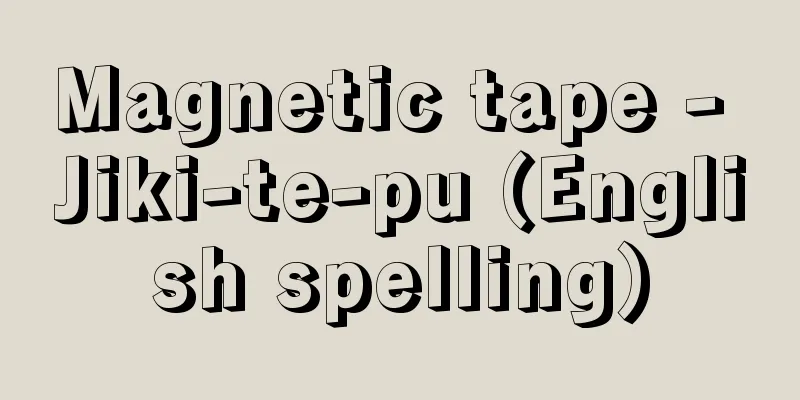Magnetic tape - Jiki-te-pu (English spelling)

|
It is a method of magnetically recording electronic information onto tape with a ferromagnetic medium attached to its surface, and can store large amounts of data safely for long periods of time at low cost even without a power source. Tapes are available for audio, video, and data/computer use, and the first two are available for analog recording and digital recording. The base film (polyethylene terephthalate, etc.) makes up more than 90% of the total thickness of magnetic tape, which is several to several tens of micrometers. Cheap, popular tapes are coated with a magnetic powder of gamma iron oxide (γ-Fe 2 O 3 ), video tapes are coated with a material that also contains cobalt, and metal tapes for high recording density are vapor-deposited with cobalt and nickel. Resin is used for the powder binder and cartridge. Tape is usually manufactured by first making a film with the magnetic medium attached to one or both sides, which is then cut to a width of 3 or 4 meters and wound onto a reel. It is then cut to a width according to the intended use and loaded into standardized plastic containers or reels. To write electronic information onto tape, a magnetic head, which has a coil wound around a soft magnetic material, is brought close to the tape with a tiny gap, and the coil's signal current magnetizes the magnetic medium on the tape surface. In this way, information is recorded in the horizontal (longitudinal) direction, as if tiny magnets were lined up on the tape's film surface. To read information, the magnetic field written on the tape is detected as an induced current in the coil, or as a change in resistance in the magnetic effect element. To erase information, a somewhat strong high-frequency magnetic field is applied, breaking up the alignment of the tiny magnets and returning them to their original state. For analog audio recording, there are open-reel tape recorders with a width of 1/4 inch (about 6 mm), professional multi-track recorders with a width of up to 2 inches, audio cassettes and microcassettes for answering machines that are 3.8 mm, 3/4 inch cassette tapes for digital audio recording, and 1/2 inch and 8 mm wide tapes for professional multi-track recording. For video, there are the early open-reel 2 inch tapes, followed by the 1 inch and unified 1/2 inch tapes, videocassettes include the home VHS 1/2 inch and 8 mm tapes, as well as the professional U standard 3/4 inch and VX standard 1/2 inch tapes, and for computers there are 2.1 inch open-reel tapes as well as 1/2, 1/4 inch, 8 and 3.8 mm wide cassettes. The prototype of magnetic tape is the piano wire used in the Telegraphophone, a recording and playback device developed by Poulsen of Denmark in 1881. In 1927, Austrian scientist Fritz Pfleumer (1881-1945) invented magnetic tape, which was made by coating paper tape with magnetic powder particles. In 1935, a recording and playback device using a plastic tape base was developed and exhibited in Germany under the name Magnetophon, which Hitler used for propaganda purposes. After World War II, it was brought to the United States, and magnetic tape production became active around the world. In 1962, Philips of the Netherlands announced the compact cassette, which was made into a cartridge. Currently, efforts are being made to increase the recording density for backup purposes, etc. [Michinori Iwata] "Memory and Recording: An Introduction to Information Mechanics" by Kyosuke Ono, Norio Takagawa, and others (1995, Ohmsha) "Electronics of Information Recording" by Koichi Sadashige (2001, Coronasha) [References] | | | | |Source: Shogakukan Encyclopedia Nipponica About Encyclopedia Nipponica Information | Legend |
|
強磁性媒体を表面に付着したテープに電子情報を磁気的に記録するもので、大容量記録を電源を除いても低コストで安全に長期間保持できる。テープにはオーディオ用、ビデオ用とデータ/コンピュータ用のものがあり、前二者にはアナログ記録方式用とデジタル記録方式用のものがある。 磁気テープの全厚数~数十マイクロメートルの9割以上を占めるベースフィルム(ポリエチレンテレフタレートなど)に、安価・普及型テープはガンマ酸化鉄(γ-Fe2O3)の磁性粉体を、ビデオテープはさらにこれにコバルトを含めたものを塗布したもので、高記録密度用のメタルテープはコバルト・ニッケルなどを蒸着したものである。粉体のバインダーやカートリッジには樹脂を用いている。テープの製法は、普通まず片面または両面に磁性媒体を付着したフィルムをつくり、これを幅3、4メートルに裁断してリールに巻き取る。さらに、使用目的に応じた幅で裁断して規格化されたプラスチック容器やリールに装着する。 テープへの電子情報の書き込みは、軟磁性体にコイルを巻いた磁気ヘッドの微小ギャップをテープに近づけ、コイルの信号電流によってテープ面の磁性媒体を磁化する。こうして、情報はテープの膜面に微小磁石を並べたような形で、水平面(長手)方向に記録される。読み出しはテープに書き込まれた磁界をコイルの誘導電流として、または、磁気効果素子の抵抗変化として検知する。消去にはやや強い高周波の磁界を加え、微小磁石の並びを崩して元に戻す。 音声のアナログ記録のテープレコーダー用としては、オープンリールの1/4インチ(約6ミリメートル)幅のもの、業務用には最大2インチ幅のマルチトラックレコーダーがあり、オーディオカセットや留守番電話機用などのマイクロカセットは3.8ミリメートル、デジタル音声記録には3/4インチのカセットテープ、業務用マルチトラック用には1/2インチのほか、8ミリメートル幅のテープがある。ビデオ用には初期のオープンリールの2インチ、続く1インチから統一型の1/2インチ幅が、ビデオカセットには家庭用のVHSの1/2インチ、8ミリメートル幅のテープのほか、業務用のU規格の3/4インチ、VX方式の1/2インチ幅が、コンピュータ用には2.1インチのオープンリールのほかにカセットの1/2・1/4インチ、8・3.8ミリメートル幅のものがある。 磁気テープは1881年にデンマークのパウルセン(ポールセン)が開発した録音・再生装置テレグラフォンに用いたピアノ線が原型である。1927年にはオーストリアの科学者プロイメル(フロイマー)Fritz Pfleumer(1881―1945)が磁性粉粒子を紙テープに塗布した磁気テープを発明。1935年にはプラスチックテープ基板の録音・再生装置がマグネトフォンの名でドイツで開発・展示され、ヒットラーはこれを宣伝に利用。第二次世界大戦後、アメリカに持ち込まれ、磁気テープの生産が世界で活発化した。1962年にはオランダのフィリップス社はカートリッジ化したコンパクトカセットを発表。現在、バックアップ用などに記録の高密度化が進められている。 [岩田倫典] 『小野京右・多川則男他著『記憶と記録――情報機械学のすすめ』(1995・オーム社)』▽『貞重浩一著『情報記録のエレクトロニクス』(2001・コロナ社)』 [参照項目] | | | | |出典 小学館 日本大百科全書(ニッポニカ)日本大百科全書(ニッポニカ)について 情報 | 凡例 |
Recommend
Sagain - Sagain
Emperor Saga's villa in Saga, west of Kyoto. I...
Abi (Abi) - Abi (English spelling) diver [UK]
A general term for birds in the family Gaviidae (l...
Jigme Singi Wangchuk (English)
…[Toshiaki Oji] [Toshihiro Tsukihara]. … *Some of...
false door
...In the royal tombs of Abydos, a simple mastaba...
Graphology
The study of the relationship between handwriting...
Galilean binoculars - Galilean binoculars
...Another feature is that, because binoculars ar...
Macadamia - Macadamia
Macadamia is a fruit tree of the Proteaceae famil...
《Engiyaku》 - Engikyaku
...The 12 volumes of the code were compiled in 90...
Microseisms
…(2)In electrical engineering, when a direct curr...
Saitama Prefecture - Saitama
A prefecture in the central west of the Kanto regi...
Memorial Hall - Kinendo
…Christian architecture consists of churches (cat...
cervix
…the part of an animal's body that narrows so...
thé (English spelling) the
…The words that mean “tea” around the world today...
Family: Chloroptera
…The larvae of the Agromyzidae (leafminers) are l...
Cloud forest - Mist forest
A forest that develops in places where clouds and ...









